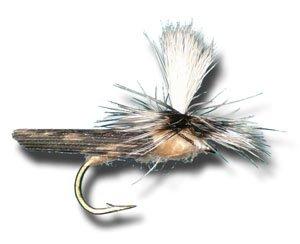Parachute Caddis
As the snow begins to melt and the trees brighten with their spring colors, anglers gear up for some of the best dry fly fishing the season has to offer. The notorious caddis, the small meat-and-potatoes insect of the trout world, begins to hatch. Anglers flock to streams across Montana in hopes of hitting the caddis hatch just right. There are many caddis patterns out there today and many of them can work in varying situations. One pattern that I’ve found to be productive no matter what stage of development the caddis are in is the parachute caddis. This pattern is easy to tie, which is good for me, because when fish are steadily feeding on caddis I find myself back at my vice weekly, tying more and more patterns to replace the ones that did not make the trip home from the river.
Materials
Hook: Dai-Riki 100 or 125
Shuck: amber colored Antron or similar substitute
Abdomen: dark olive uni thread 8/0
Thorax: tan, olive, black
Hackle: Natural Grizzly
Post: White poly
Underwing: olive crystal flash
Wing: Deer hair short fine
Instructions
1. To begin this pattern, pick out your favorite dry fly or emerger hook (either one will work fine).
2. Wrap your thread to the end of where you will create your thorax and tie in a sparse clump of Antron extending past the hook bend.
3. Wind your thread up to the thorax, keeping the thread wraps evenly spaced to create a smooth body.
4. Next, tie in your white poly yarn in the middle of the thorax area to create your post.
5. Add a small amount of head cement to the post to keep it in an upright position for you to wrap your hackle.
6. Wrap your thread behind the post and secure your crystal flash underwing and a thick clump of deer hair. To better secure the hair after your initial tie-down wraps, split the remaining butts into thirds and put tight wraps through each third, binding it down to the hook shank.
7. Trim the butts of the hair down very close to the shank of the hook—this will create a tapering effect throughout the thorax and make it easier to work the rest of the materials into the fly.
8. Wrap your dubbing up to the post and secure in your grizzly hackle.
9. Dub the rest of the body and return to the poly yarn post.
10. Wrap your hackle around the post and tie it off at the base.
This pattern is effective for all of the types of caddis flies that are so prevalent here in Montana. The parachute-post style of this fly makes it a great freestone pattern. You can also substitute black poly yarn for the white for those low-light days on the river.
Fishing caddis dry flies can lead to some of the most exciting spring fishing due to the aggressive nature of the fish around these small flies. Enjoy the upcoming spring weather and enjoy the wonderful dry fly fishing opportunities the caddis hatch can bring.
Josh Cavan spent much of his childhood fishing the Yellowstone, Bighorn, Stillwater, and Boulder Rivers. After six years fishing and guiding on the Madison River and local area creeks, he now calls Bozeman home. Josh has been tying flies for over eight years, four of which have been for fly shops and clients.











